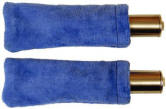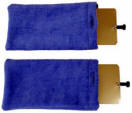Analog vs. Digital
The
question always arises about the type of signal that should be used.
It is generally accepted that the most effective of these frequency
generating devices will deliver an analog signal, versus a digital
signal. Analog is better because it is in many ways a more natural
frequency with a natural "float". It includes the sub-tones and overtones to the base
number, providing a maximized fullness, essentially a richness of
tonal qualities. A very big part of that is what is called the
harmonics. An audiophile understands this. Those who desire only
"true" sound on their stereo systems insist on analog devices for
just this reason.
The current analog vs. digital discussion is wrought with
misconceptions and disinformation. Such as, digitally generated
frequencies do not vary, which implies that they do not have
overtones and undertones. This would only be true if the
frequencies remained digital. That is why digital frequencies
from DDS (Direct Digital Synthesis) and DSP (Digital Signal
Processing) are converted to analog before they are put out of
quality generators. These Digital-to-Analog Converters are called a
DAC for short. You can see in the diagram below that a frequency
comes out of a DDS or a DSP looking like stairs. The signal then
goes through a DAC or Digital-to-Analog Converter. Then it goes
through a Low-Pass or Bandpass Filter to finish the analog
conversion. Now the frequency that you have is a very accurate
analog frequency with all the overtones and undertones of that
analog frequency. The analog frequency produced by a digital chip
can be swept up or down with more accuracy than any old tube analog
instrument. The most important thing to remember is the frequency
has to be converted to analog before it is output from the frequency
generator.

Digitally
produced frequencies converted to analog are far superior to any
signal that comes from an old antique tube type analog frequency
generator. Antique tube type generators are very limited. If I want
a frequency of 2128.5, an old tube analog generator would not be
accurate enough to give me that frequency to use. It could only give
me 2128. Also, digitally converted frequencies allow me to sweep
with far more accuracy than old analog tube type instruments. Even a
thousandth or millionth of a frequency is possible even though this
kind of accuracy is not needed. This is something that a purely
analog instrument could not do as accurately. Digitally produced
frequencies when converted to analog can accurately produce minute
details. These analog frequencies when converted to a square wave
waveform produce square wave harmonics. Some claim that their
instruments which output analog frequencies produce advanced analog
harmonics, but this is just sales hype. All the digital to analog
frequency generators on the market today that have been tested with
a spectrum analyzer produce the same analog harmonics. Anyone
claiming to have some form of superior advanced square wave
harmonics is just giving you lots of sales hype. (Our frequency
generator uses this technology, of course.)
Why Power Output Is Important In A Frequency Generator.
When comparing various instruments, power output is an important
consideration. The first direct contact style instrument developed
by John Crane and John Marsh worked well, but were underpowered like
most of the pad instruments built today. Most modern contact
pad generators' power output is only about 0.20 of 1
watt, and they run just 1 audio frequency at a time. Our generator, when
running in "Audio Mode", runs up to 8 frequencies simultaneously
(huge time saver) with an output of .75 watts, or 3.75 times more power.
When used with the optional RF carrier turned on, max power output is
4.7 watts and is nearly 25 times more powerful
than these other instruments. With the use of the optional
15 watt amplifier it is 75 times more
powerful than the .2 watt standard.
Output of Contact type
instrument vs. Ray Tube?
  Direct
contact, or 'pad machines', instruments deliver frequencies through direct contact
using plates or cylinders,
while plasma ray tube instruments transmit frequencies indirectly
through the air. Direct contact makes it possible to get the
full energy into the body without power loss. The tools seen
here use cloth covers also that are used wet. The moisture
improves conductivity. Direct
contact, or 'pad machines', instruments deliver frequencies through direct contact
using plates or cylinders,
while plasma ray tube instruments transmit frequencies indirectly
through the air. Direct contact makes it possible to get the
full energy into the body without power loss. The tools seen
here use cloth covers also that are used wet. The moisture
improves conductivity.
Indirect contact
though a gas filled tube (plasma and/or argon) is efficient also,
and allows for a 'hands free' application. However, beware
those who claim that you can simply sit in the same room
with one of these plasma ray tubes to get the full effect... this
is incorrect! These are great, but you DO have be very close to it for
true therapeutic value.
 The laws of physics in regards to
signal loss come into play when using a ray tube. It requires
much more power to deliver its output. For
every foot that you move the ray tube away from the body you have to
divide the power output by the ray tube by a factor of 4.
Example: If you
have 50 watts of power coming out of a ray tube, then at one foot
away from the ray tube you only have 12.5 watts.
At two feet you only have 3.125 watts and at 3 feet you only have
about .78 of a watt. Because of this loss, researchers and
doctors from the 30's had to stay within
6 to 12 inches of the body
with the ray tube. The laws of physics in regards to
signal loss come into play when using a ray tube. It requires
much more power to deliver its output. For
every foot that you move the ray tube away from the body you have to
divide the power output by the ray tube by a factor of 4.
Example: If you
have 50 watts of power coming out of a ray tube, then at one foot
away from the ray tube you only have 12.5 watts.
At two feet you only have 3.125 watts and at 3 feet you only have
about .78 of a watt. Because of this loss, researchers and
doctors from the 30's had to stay within
6 to 12 inches of the body
with the ray tube.
Today, many ray tube instruments output 100 watts or more.
Some of these manufacturers recommend to stay at least 3 feet away from the ray tube,
due to what they've coined 'the null zone'. This is NOT A
THING.
There is NO 1 foot to 3 foot 'null zone' (non-effective range).
In fact, JUST THE OPPOSITE IS TRUE! (this industry is a
minefield of mis information!) Stay within 3 feet for
best results!
With a direct contact instrument, this power
loss is not a problem; therefore, one does not need to use anywhere
near the same power levels used by a ray tube instrument.
20MHz Frequency Generator - Specifications
 |
Stand Alone Frequency Generator: Unlike some
generators on the market, this is designed to be a simple, easy to operate,
stand alone frequency generator requiring no
complicated computer interface. Computer operated generators can generally
work well if power output is adequate (which
is most of them), but many people have commented on how
confusing the software can be with some products. Our customers
appreciate that they are not required to have a
computer to operate any of our instrument's
capabilities. |
|
 |
Frequency range:
0.01 to 20,000,000 Hertz. |
|
 |
Waveforms: Square and Sine
wave. Square wave up to 400,000 Hertz. Sine to
20,000,000 Hertz |
|
 |
Two circuits.
"Audio Mode" circuit capable of outputting 8
square wave frequencies simultaneously from 1 to 40,000 Hertz.
And also 1 square wave frequency at time up to 400,000 Hertz!
(This circuit
uses NO RF carrier frequency.) |
|
 |
Two circuits. "RF Mode" circuit capable of outputting 8
square wave frequencies simultaneously from 1 to 40,000 Hertz
'piggybacked' onto a 3.1 Mhz Carrier Frequency.
(like Dr. Rife!) Also, capable of running
1-2 RF frequencies from 40,000Hz - 20,000,000 Hz. For best results, leave it in
this mode. |
|
 |
Carrier Wave:
3.1 MHz RF (3,100,000
Hertz Radio
Frequency) for more power for deeper penetration.
The RF carrier wave also produces 'sideband harmonics' like Rife's original 1930's, 1940's
and 1950's equipment! This is an important
part of Rife's own successes. (in his own words) NOTE: Carrier wave can be turned off so the
user can operate it as a
standard audio frequency generator like most on the
market today. |
|
 |
Power output: RF Mode: Variable up to
4.7 watts (RF = Radio
Frequency) |
|
 |
With Optional RF Mode
Amplifier: Variable up to
15 watts |
|
 |
Power output: Audio Mode: Variable
up to .75 watts |
|
 |
Voltage output in RF mode:
110 volts. (47 times
more powerful than most standard frequency
generators.) |
|
 |
Voltage output in Audio Mode:
36 volts |
|
 |
Time Saving
Feature: Simultaneously Runs 8
audio frequencies
(1-40,000Hz), and Simultaneously Runs 2
frequencies from 40,000-20,000,000 Hz. (HUGE TIMER
SAVER) |
|
 |
883 Preset
Channels. Comprehensive and easy-to-run PRESET
Channels allow you to start experimenting immediately.
(A Channel stores frequencies for easy use.) |
|
 |
Channel capability:
48 Run up 48
frequencies in sequence, or in 6 groups of
8 frequencies each. |
|
 |
Programmable channels: 2000.
883 preset Channels leaves you with 1,117 blank Channels.
You can use these to make your own "Custom Channels"
that will remember the frequencies you load into it. |
|
 |
Outputs: Four. 2
positive (red) and 2
negative (black). Using 4 points of contact
(hands and feet) allows more signal to permeate the
body. |
|
 |
Frequency output:
Digitally
accurate frequencies. (converted to analog using a Digital-to-Analog
convertor) |
|
 |
Resolution: 1/100th of a Hertz: (7.83 Hz)
Beyond this is unnecessary. |
|
 |
Duty cycle capability: 10% to
100% square wave duty cycle. |
|
 |
Gating (or pulsing) range: 1 -
5000 Hertz (advanced feature....
you don't have to use this) |
|
 |
Gating duty cycle range: 10%
- 90%. 'Save Gating' Feature: Allows you to
save, in any channel, gating turned ON whenever that
channel is used. |
|
 |
Sweep Feature:
Run 1 frequency at a time, from 1 to 20
million Hertz. (A Sweep runs ALL frequencies
between 2 chosen points. Ex: 10,000Hz - 20,000Hz)
|
|
 |
Converge sweeps:
Run 2
frequencies at a time, from 1 Hertz to 20 million Hertz. |
|
 |
Channel sweep: Variable,
2 Hertz - 20,000 Hertz. The feature allows you to
'hover' above and below your target frequencies.
This helps to prevent the organisms from adapting.
(Ex. A 1000 Hz Channel Sweep on a frequency
of 10,000 would sweep from 9,500Hz to 10,500Hz)
|
|
 |
Display: LCD |
|
 |
L.E.D: RF indicator light
confirms RF output. |
|
 |
Computer software:
Not a
necessity really. It is mostly used for programming
your own custom channels, or restoring any lost programmed channels
that may be accidentally deleted. |
|
 |
Worldwide AC Adapters: Two switching
110/240 volt power supplies for worldwide use. |
|
 |
DVD Training Guide
and Paper Operations Manual. |
|
 |
Free software
updates (when rare updates occur.) |
|
 |
Free lifetime
phone training and support. |
|
 |
60 Day Money Back Guarantee
(less shipping cost) if returned in new condition. 10%
restock fee. |
|
 |
Two Year Warranty on
parts and labor. (as of 1/1/16) |
|
 |
Broadcast
Capable w/Optional Amplifier & Plasma Tube! |
|
|
A
master oscillator
combined with a powerful amplifier is needed to use the
gas filled tube method of broadcasting the frequencies. If you are
wanting to use the more powerful, versatile
1930's/1950's radiant method, then this
amplifier is the instrument you will want to own.
-
Power output: 190 watts
-
Ability to run up to 8 frequencies (up to 40,000
hertz) through a gas filled tube. No other
instrument has this capability! (Rife ran up to 10 at a
time.)
- Original plasma gas filled vacuum tube with the
ability to use a variable frequency from 1 to 20,000,000
million Hertz. It also has a variable built in
carrier frequency which goes from 2.2 to 3.8 MHz.
- Uses the superior high voltage - low current
design over the low voltage - high current design. |
| |
|
 |
Hands free
Operation / Run it While You Sleep Useful range is
about 30 feet when using gas tube. However, due to the laws of
physics there are limitations to gas filled tubes and
metal antennas that need to be understood. Both are very
efficient and about 100% of the energy that you put into
them comes out. But for every foot that you move
away from these antennas you lose 75% of the power they
output. Example: With a 207 watt
output, at one foot away from the gas filled tube you
will get 47.5 watts. At two feet away you
only have 11.85 watts, and at 3 feet you only have 2.97
watts. Because of the laws of physics it is important to
be as close to the gas filled tube as you can get if you
want the greatest amount of the energy that comes out of
it. One to three feet distance away from the gas
tube would be the best choice for maximum results.
Closer the
better.
Suggested range:
1 inch to 6 feet. Because there is NO 1 foot to 3 foot
'null zone' (non-effective range, as some manufacturers
state!)
it is not necessary to stay 3 to 6 feet away from the
gas tube because it outputs the same as the
1930's/1950's equipment that was used within 6 inches of
the target area. |
| |
|
When you are ready to start your own experiments
and you want the most powerful, versatile frequency generator available,
please contact us.
|
20,000,000 Hz Frequency Generator

Sorry,
due to FDA and contractual
constraints, we can not show you the frequency generator we carry by
name
on this website. To get full details and see it up
close, just email us right now with this link below.
You
will receive an 'auto-reply' immediately with model,
pictures, pricing, details, etc... Thank you.
rifemachineinfo@gmail.com
We do NOT share your
email and we won't spam you.
Or call to speak with us directly.
 |
|

If you need a little help with financing, we found a
great company with almost 100% approvals.
|
| |
|
This is not
a ProWave 101, Wellness Pro, Global Wellness, Energy Wellness,
Detox Box, Wright Laboratories, RPG 900, BCX Ultra, Bio
Solutions PERL, Plasma Plus, or EMEM Ray Tube type
frequency generator. |
Frequency Generator Disclaimer:
We
are not licensed medical professionals, nor do we imply so. We
do not prescribe, diagnose, or provide medical services or
advice in any way. Statements
contained on these pages about a frequency generator, alternative medicine, holistic
health, or any other topics have not been evaluated by the Food
and Drug Administration. The information found here is not
intended to diagnose, treat, cure, or prevent any disease.
Suggestions and ideas presented in this document are for
information only and should not be interpreted as medical
advice, meant for diagnosing illness, or for prescriptive
purposes.
Frequency Generator
|